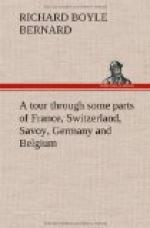I had much reason to be satisfied that I took this road to Calais, instead of going by the canals, as the country was much diversified, and the view from Cassel was one of the most striking and extensive that I had ever seen. Notwithstanding that the month of November is not calculated for seeing a country to advantage, some of the richest and best cultivated provinces of France and Flanders are discovered from this commanding situation. The scene is bounded on one side by the sea and on the other by the mountains of Hainault. Those who are acquainted with the country assert that from Cassel you can see thirty towns or considerable villages, of which seventeen are fortified. Cassel itself is by no means remarkable; it was at one time a place of great strength, but its fortifications have gone to decay, although its situation must always render it a strong position. After a considerable descent on leaving Cassel, we arrived in the plain, which extends to the coast, with but little variation. It is fertile in corn and produces hops. There are several rich pastures and a tolerable proportion of wood. This day we travelled entirely in the department du Nord, where the roads are much attended to. I observed a few country houses and a chateau of General Vandamme.
Berg is a considerable town, but badly situated; the country from thence to Dunkirk is a flat and marshy plain, resembling those extensive tracts which occupy a large proportion of the counties of Cambridge and Lincoln. It abounds with canals and drains, which in some places are higher than the fields, but this uninteresting district feeds large herds of cattle, and is in many parts well cultivated. One of the chief canals leading to Dunkirk runs parallel with the road for a great distance, its banks are planted with trees, which have a stunted appearance, owing probably to their proximity to the sea. I observed on the canal several boats laden with the produce of the country, as well as the stage boats. Dunkirk is well built, and the streets being spacious it makes a favourable impression on the mind of the traveller, who is perhaps more liable to the force of a first impression than most others. Some of the churches and public buildings are handsome and the number of inhabitants is estimated at 22,000. Its name is said to originate from a church built here by the Duns in 646, and in Flemish its name signifies the church of the Duns. There is much similarity between many words in the English and Flemish, but the latter cannot claim the praise of agreeableness.




